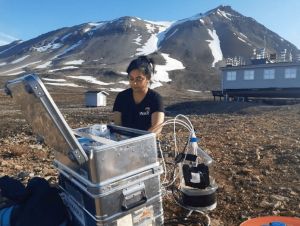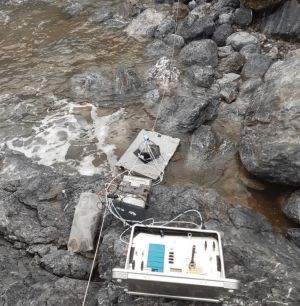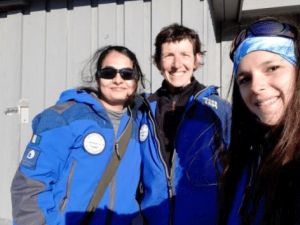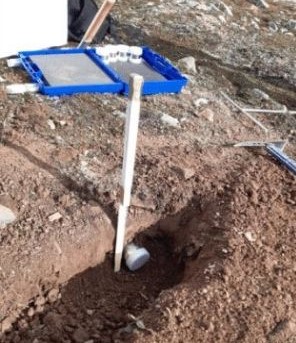Project: “Molecular steps of new particle formation in the Arctic atmosphere part II - long term measurements”, funded by SIOS Access Programme in 2021.
By Roseline Thakur (Project Manager).
Climate change influences the release of biogenic volatile organic compounds from Arctic soil, vegetation and perhaps even snow. Melting of sea ice and other climate change effects influence also the marine ecosystem, including phytoplankton and their productivity. Gas phase vapour emissions (methane sulphonic acid, sulphuric acid, iodic acid, or organics), whether emitted from phytoplankton or other ecosystems of the Arctic, may play an important role in new particle formations in the atmosphere. The type of vapour involved in the initiation of new particle formation and its subsequent growth depends a lot upon the location of the study and season during which the observations were made.
The SIOS funded fieldwork in 2021 is part of an ongoing project that started in 2017. Results of the first campaign showed that in Svalbard, sulphuric acid and methanesulphonic acid originating from phytoplankton dimethylsulphide emissions contribute to the formation of secondary aerosols and to some extent to cloud condensation nuclei (Beck et al., 2021). The study also reported that high concentrations of organics (highly oxygenated molecules) participated in particle growth. However, the source of these organics is still unknown! Therefore tracing the source of these organics in Ny-Ålesund is the key objective for the current project.
Sophisticated and state of the art instruments which generate supporting data for this project are permanently installed in Gruvebadet, including a 'Chemical Ionization - Atmospheric pressure interface - Time of Flight' mass spectrometer, a Neutral Cluster and Air - Ion Spectrometer, a Cluster Ion Counter and an ozone analyzer. Due to the pandemic we had a gap in measurements for the year 2020. Thanks to the SIOS grant we were able to service all our instruments and return them to Gruvebadet for more long-term studies. For the first time we were successfully able to measure real-time (high-resolution) concentrations of volatile organic compounds in the ambient Arctic atmosphere.
We successfully carried out seasonal campaigns for volatile organic compounds flux - chamber measurements (March 2021 - September 2021) to measure the emissions of volatile organic compounds from snow, vegetation, bare soil, floating macroalgae and permafrost soils. We were lucky that almost all the instruments were working well throughout the campaign, thanks to our excellent team which was in rotation visiting the station and maintaining instruments. Thus we now have a comprehensive data set for real-time high-resolution concentrations of other gas phase species which are crucial for initiating new particle formation in the Arctic, like sulphuric acid, methane sulphonic acid, iodic acid which can be used to investigate the complexity of new particle formation in the Arctic. Number size distributions for particles 2.5 - 40nm and ions (0.8 - 40 nm) were also studied during the entire campaign.
During the campaign from March-September 2021, we have collected following data:
- Aerosol precursors vapours (H2SO4, methanesulphonic acid, HIO3 all low volatile HOM-species) and naturally charged ion clusters
- Size distribution of naturally charged ion-clusters (0.8nm-40nm) and aerosol particles (2nm-40nm)
- Biogenic volatile organic compounds fluxes (monoterpenes and sesquiterpenes flux and concentrations)
- Ozone concentration
- Organic vapours from permafrost soil, vegetation, bare soil and macroalgae (Chamber experiment).
All used instruments, except two,vare still operational in Gruvebadet, Ny-Ålesund. We plan to keep them for long-term (at least as long as our funding supports us!).
As planned we did a collaborative field work with scientists from Institute of Geosciences and Earth Resources, CNR Italy and collected soil cores the active layer of the permafrost site in Ny-Ålesund.The soil core samples were sent as cold shipment to University of Helsinki to carry out further lab studies on the volatile organic compounds emissions form these cores.





Photo 1. A suite of atmospheric measurement instruments in Gruvebadet, Ny-Ålesund (year 2021). Photo 2. Manual volatile organic compounds flux measurements carried out over the tundra by Roseline Thakur in July 2021. Photo 3. Floating flux chamber measurements to trap the emissions from macro/micro algae near Blomstrand, Svalbard, August 2021. Photo 4. Roseline Thakur (INAR) and scientists from Institute of Geosciences and Earth resources Ilaria Baneschi and Linda Franceschi. Photo 5. Soil core collection from the active layer.
Overall this year’s campaign funded by SIOS access grant 2021 and Horizon-2020 ER-StG GASPARCON; Finnish Academy project CONDENZ and Finnish Academy Research Fellow funding, was a success. Despite the travel hassles and personal losses faced by our team members because of the pandemic we managed to stick to our timelines planned for the entire campaign. I sincerely thank my project head Mikko Sipilä and all my team members (Lauriane Quéléver, Tuuli Lehmusjärvi, Tuija Jokinen, Mathew Boyer, Zoe Brasseur, Frans Graeffe and Kimmo Nietola) for making this campaign happen! Special thanks to scientists/researchers at Dirigibile Italia Arctic station for all their support on site as well as remotely.



























